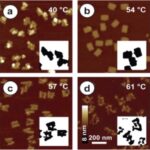- Home
- Research
- Nanobiophotonics
- Research results
- DNA Origami as a Self-organizing Molecular Technique for the Implementation of Innovative Photonic Materials
DNA Origami as a Self-organizing Molecular Technique for the Implementation of Innovative Photonic Materials

19.08.2015
The DNA origami technique is an innovative molecular approach to manufacturing complex nanostructures. It allows the targeted position-specific arrangement of plasmonic nanoparticles or other functional units, such as, for example, fluorophores in the nanometer range for the implementation of novel nano-optic arrangements.
DNA-based molecular constructions have great potential as a basis for novel nanostructures. Through their ability to biomolecularly self-organize, these molecules can be folded into defined structures in a targeted and non-contact manner with an accuracy that has not yet been achieved before. The so-called DNA origami technique (Rothemund 2006) makes the highly-parallel production of 2-D nanostructures (at dimensions of 50-100 nm) with a position-specific coordinate system possible. Both plasmonic nanoparticles and nanoscale elements can be arranged in this system in a targeted manner. The hybrid nanostructures (e. g. nanolenses) produced in this way can be used, for example, as highly-sensitive novel optical sensors or as waveguide structures in nanooptics.
Current research is focused on isothermal folding at low temperatures, which facilitates the inexpensive production and careful implementation of nanoparticles and molecular components. First, both the optimal temperature range and duration of folding of 2-D origami were studied and the 80°C to 90°C of the standard protocol avoided. By adding a reaction additive, this temperature range was shifted into the physiological range. By additionally extending the duration of incubation, it is even possible to achieve successful DNA origami synthesis at room temperature.
In addition, optimization tests for the immobilization of 2-D origami were carried out. Fundamental knowledge was gained on the immobilization process; this makes it possible to arrange the DNA superstructures in a targeted manner in a type of self-organizing process. Using retracting drop boundaries during immobilization, DNA origamis were able to be arranged in a targeted manner in 2-D patterns. Future work is focused on studying the potential application of this method in the production of novel nano-optic functional elements.
In the picture above:
Corrosion of silver nanoprisms overnight: on the corners, a remodeling of the silver occurs. The atomic force microscope image allows this corrosion to be traced with time resolution.
In the picture below:
Surface mobility and ordered restructuring of immobilized DNA origami.

